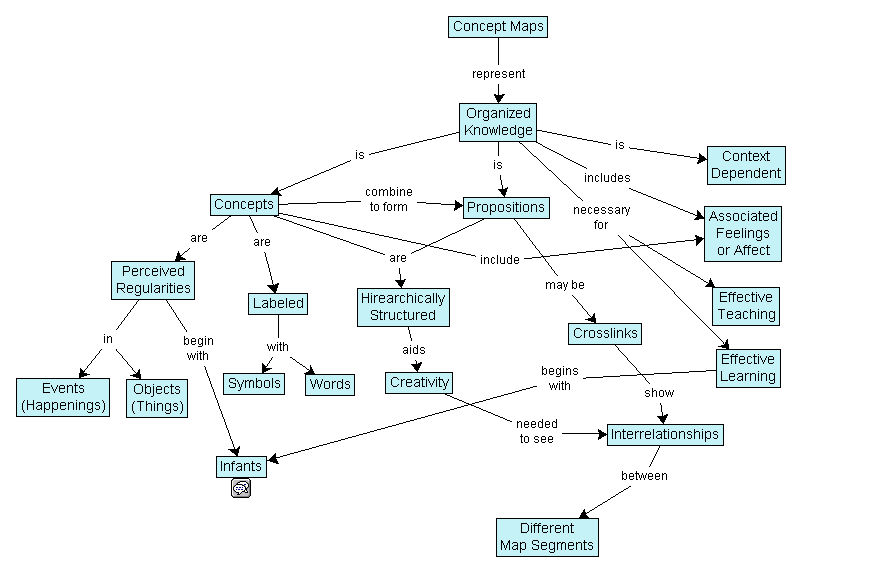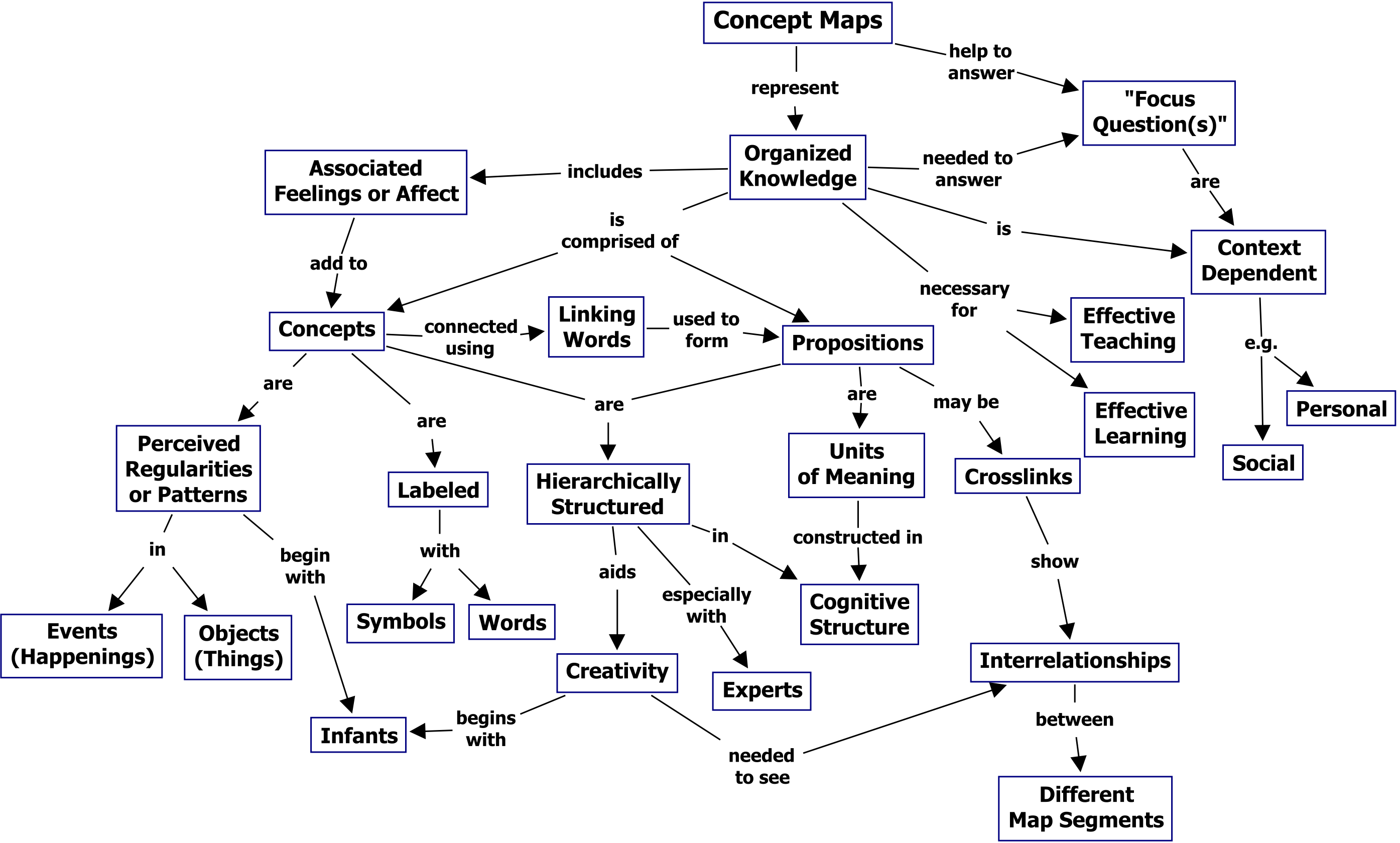Concept Map
Jump to navigation
Jump to search
A Concept Map is a knowledge graphical representation that shows the semantic relations between concepts.
- AKA: Semantic Map, Conceptual Diagram.
- Context:
- It can be the output of a Concept Mapping System.
- It can link Words (that represent the Concept) with Directed Edges (that suggest Relationship Direction).
- Example(s):
- A concept map about electricity:

- A concept map created using IHMC CmapTools [1] :

- A concept map about electricity:
- Counter-Example(s):
- See: Spider Diagram, Modelling Graph, Information Mapping System, Lexical Distribution-based Concept Mapping, Semantic Network, Conceptual Framework, Group Concept Mapping, INomological Network, Object-Role Modeling.
References
2019a
- (Wikipedia, 2019) ⇒ https://en.wikipedia.org/wiki/Concept_map Retrieved:2019-6-9.
- A concept map or conceptual diagram is a diagram that depicts suggested relationships between concepts. [1] It is a graphical tool that instructional designers, engineers, technical writers, and others use to organize and structure knowledge. A concept map typically represents ideas and information as boxes or circles, which it connects with labeled arrows in a downward-branching hierarchical structure. The relationship between concepts can be articulated in linking phrases such as causes, requires, or contributes to.[2]
The technique for visualizing these relationships among different concepts is called concept mapping. Concept maps have been used to define the ontology of computer systems, for example with the object-role modeling or Unified Modeling Language formalism.
- A concept map or conceptual diagram is a diagram that depicts suggested relationships between concepts. [1] It is a graphical tool that instructional designers, engineers, technical writers, and others use to organize and structure knowledge. A concept map typically represents ideas and information as boxes or circles, which it connects with labeled arrows in a downward-branching hierarchical structure. The relationship between concepts can be articulated in linking phrases such as causes, requires, or contributes to.[2]
2019b
- (Wikipedia, 2019) ⇒ https://en.wikipedia.org/wiki/Mind_map#Differences_from_other_visualizations Retrieved:2019-6-9.
- Concept maps: Mind maps differ from concept maps in that mind maps focus on only one word or idea, whereas concept maps connect multiple words or ideas. Also, concept maps typically have text labels on their connecting lines/arms. Mind maps are based on radial hierarchies and tree structures denoting relationships with a central governing concept, whereas concept maps are based on connections between concepts in more diverse patterns. However, either can be part of a larger personal knowledge base system.
- Modelling graphs: There is no rigorous right or wrong with mind maps, relying on the arbitrariness of mnemonic systems. A UML diagram or a semantic network has structured elements modelling relationships, with lines connecting objects to indicate relationship. This is generally done in black and white with a clear and agreed iconography. Mind maps serve a different purpose: they help with memory and organization. Mind maps are collections of words structured by the mental context of the author with visual mnemonics, and, through the use of colour, icons and visual links, are informal and necessary to the proper functioning of the mind map.
2019c
- (BYU, 2019) ⇒ https://ctl.byu.edu/tip/concept-mapping Retrieved:2019-6-9.
- QUOTE: A concept map is a visual organization and representation of knowledge. It shows concepts and ideas and the relationships among them. You create a concept map by writing key words (sometimes enclosed in shapes such as circles, boxes, triangles, etc.) and then drawing arrows between the ideas that are related. Then you add a short explanation by the arrow to explain how the concepts are related.

- QUOTE: A concept map is a visual organization and representation of knowledge. It shows concepts and ideas and the relationships among them. You create a concept map by writing key words (sometimes enclosed in shapes such as circles, boxes, triangles, etc.) and then drawing arrows between the ideas that are related. Then you add a short explanation by the arrow to explain how the concepts are related.
2008
- (Novak & Canas, 2008) ⇒ Joseph D. Novak, and Alberto J. Cañas (2008). Technical Report IHMC CmapTools 2006-01 Rev 2008-01: http://cmap.ihmc.us/docs/theory-of-concept-maps
- QUOTE: Concept maps are graphical tools for organizing and representing knowledge. They include concepts, usually enclosed in circles or boxes of some type, and relationships between concepts indicated by a connecting line linking two concepts. Words on the line, referred to as linking words or linking phrases, specify the relationship between the two concepts. We define concept as a perceived regularity in events or objects, or records of events or objects, designated by a label. The label for most concepts is a word, although sometimes we use symbols such as + or %, and sometimes more than one word is used. Propositions are statements about some object or event in the universe, either naturally occurring or constructed. Propositions contain two or more concepts connected using linking words or phrases to form a meaningful statement. Sometimes these are called semantic units, or units of meaning. Figure 1 shows an example of a concept map that describes the structure of concept maps and illustrates the above characteristics.

Figure 1. A concept map showing the key features of concept maps. Concept maps tend to be read progressing from the top downward.
- ↑ Peter J. Hager, Nancy C. Corbin. Designing & Delivering: Scientific, Technical, and Managerial Presentations, 1997, . 163.
- ↑ Joseph D. Novak & Alberto J. Cañas (2006). "The Theory Underlying Concept Maps and How To Construct and Use Them", Institute for Human and Machine Cognition. Accessed 24 Nov 2008.